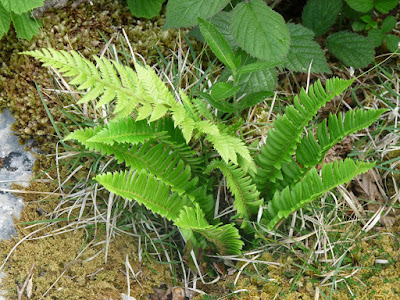 |
| Schmalhauseneii No.1 (Click over to enlarge) |
Saturday 27th May 2017 - Dalton, The Common and Lancelot Clark Storth (CWT) 1000hrs to 1400hrs
Very humid sort of morning which did eventually break down with thunder storms and terrential rain showers. Just got caught out at 5 minutes from home. Nice to have a good soaking now and again - cools tha down lad!
Right from the off it was Garden Warblers in Dalton, two on the Common (which were known to me from previous years) and also three singing in Lancelot. I had the redstart calling in Dalton Crags, Tree Pipits (4) all on territory in Dalton and Lancelot. Green Woodpecker (2), Cuckoo (1) and that beautiful Whitethroat going at it with repetitive mode.... brilliant call!
I had 7 Small Heath Butterflies in Dalton and Lancelot. In fact I could have sworn I had a Ringlet in Dalton, which would be really early I guess, but can't thing of anything else it could have been and it was without doubt proper Ringlet territory.
The Limestone Bedstraw is coming out with force and can be seen all over the place. Here is a photo of todays little patch:
 |
| Limestone Bedstraw (Click over to enlarge) |
We have both Limestone Bedstraw (the rare one) and also Heath Bedstraw on Hutton Roof. But to tell the difference they say you must get your glass (at least 10x times) and check down the side of the little leaf and if the short hairs are going backward towards the stem it will be Limestone or if they are going towards the front then it will be heath. See following sketch.
 |
| A sketch to show whether it is Limestone or Heath Bedstraw the small hairs running down the side of the small leaves tell you eg: Backwards (as shown here) = Limestone |
 |
| Rare Hypericum Montanum (Pale St. John's Wort) in Dalton Crags (Click over to enlarge) This photo shows last years spike and todays show. |
 |
| Showing Holly Fern No.1 above and Holly Fern No.2 below (Click over images to enlarge) |
 |
| Click over to enlarge |
 |
| Asplenium Viride (Green Spleenwort) (Click over to enlarge) They are far more tapered than the commoner Maidenhair plus they have a green (viride) rib. |
 |
| Cystopteris fragilis - Brittle Bladder Fern (Click over to enlarge) |
 |
| This is a lovely plant I had today whilst over in Lancelot - very strong plant |
 |
| Epipactis Schmalhauseneii No.1 (Click over to enlarge) |
And we must include this very special Epipactis Helleborine variant Purpurea which I have listed as Specimen No.15 and has produced some fabulous bluish/purple flowers in the past. Well this is where we are today:
 |
| Specimen 15 - Epipactis Helleborine - var purpurea |
And finally for the fern lover I have taken this photo of the rare Southern Polypody (Cambricam)
 |
| Southern Polypody from last year (photo taken today). It always one of the last ferns to show. |




.jpg)
.JPG)
.jpg)






.jpg)




+(Small).jpg)
.JPG)





.jpg)






















